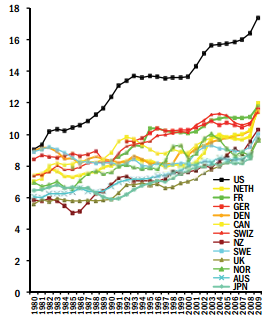Comparing of US and New Zealand health care systems
Comparing the health care systems of the US and New Zealand, it seems important to note that they are rather different. Even though both countries make their efforts to continuously enhance health care access and quality for patients, New Zealand seems to be more successful. As you noted, while the latter spends 11 percent of its GDP on health care services, then the US has to budget 14 percent in the same area. More to the point, summing up the facts revealed in the peer review, it is possible to note that mortality and morbidity rates of both countries also show the greater effectiveness of New Zealand’s system. Indeed, the recent study funded by Commonwealth illustrates that the health care spending of the US surpasses those of other large countries (see Figure 1).

Perhaps, it is partially associated with the type of health care system accepted by the US as well as with specific health problems: “The U.S. has the smaller elderly population and fewer smokers, but higher obesity rates” (Squires, 2012, p. 3). Elaborating on the mentioned point of health care spending, one may note that New Zealand’s expenditure on overweight and obese people accounted solely for 4,4 percent, as noted by Lal, Moodie, Ashton, Siahpush, and Swinburn (2012). Even though the above percentage is considerable for the country, it is less than in the US and on a global scale. It also seems essential to emphasize that plenty of Americans live without insurance coverage deprived of the opportunity to access health care services, while New Zealand’s government funds public health, thus providing citizens with the necessary health assistance.
Comparing the US and the UK health care spending
The comparison of health care spending of the two G7 group countries, namely, the US and the UK specifies that the former ranks the first place with regards to health care expenditure. It is anticipated that these amounts will grow with time, leading to the fact that 26 percent of the American GDP will be involved in their coverage. According to Milstead (2013), the health care system is composed of a range of factors that affect its overall effectiveness. With this in mind, the review of scholarly data shows that the US health care system presents several challenges despite the initiated changes. Speaking of the financial aspect, one may note the lack of adequate access and affordability along with insurance complexity (Schoen, Osborn, Squires, & Doty, 2013). Even though the country spends significant funds for supporting health care, the hybrid system cannot provide the expected outcomes.
On the contrary, the UK’s exact health care services paid by patients and out-of-pocket spending prove to be beneficial (Stabile et al., 2013). For instance, one may consider life expectancy rates: in the US, it is much lower than in the UK. Therefore, it is possible to suggest that there is an immediate need to renovate the US health care system that spends enormous funds and receives insufficient output. It should be outlined that the UK is the only one among Western countries, where the vast majority of medical institutions belong to the government. In this country, the state health system dominates supplemented by private insurance and paid medical care. Indeed, the UK’s health care system may be utilized to learn about its effectiveness by caregivers, policymakers, etc., thus enhancing the one that is accepted in the US.
References
Lal, A., Moodie, M., Ashton, T., Siahpush, M., & Swinburn, B. (2012). Health care and lost productivity costs of overweight and obesity in New Zealand. Australian and New Zealand Journal of Public Health, 36(6), 550-556.
Squires, D. A. (2012). Explaining high health care spending in the United States: An international comparison of supply, utilization, prices, and quality. Issue Brief, 10(2), 1-14.
Milstead, J. A. (2013). Health policy and politics: A nurse’s guide (4th ed.). Burlington, MA: Jones & Bartlett Learning.
Schoen, C., Osborn, R., Squires, D., & Doty, M. M. (2013). Access, affordability, and insurance complexity are often worse in the United States compared to ten other countries. Health Affairs, 32(12), 2205-2215.
Stabile, M., Thomson, S., Allin, S., Boyle, S., Busse, R., Chevreul, K.,… Mossialos, E. (2013). Health care cost containment strategies used in four other high-income countries hold lessons for the United States. Health Affairs, 32(4), 643-652.
